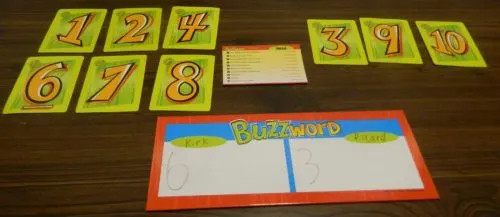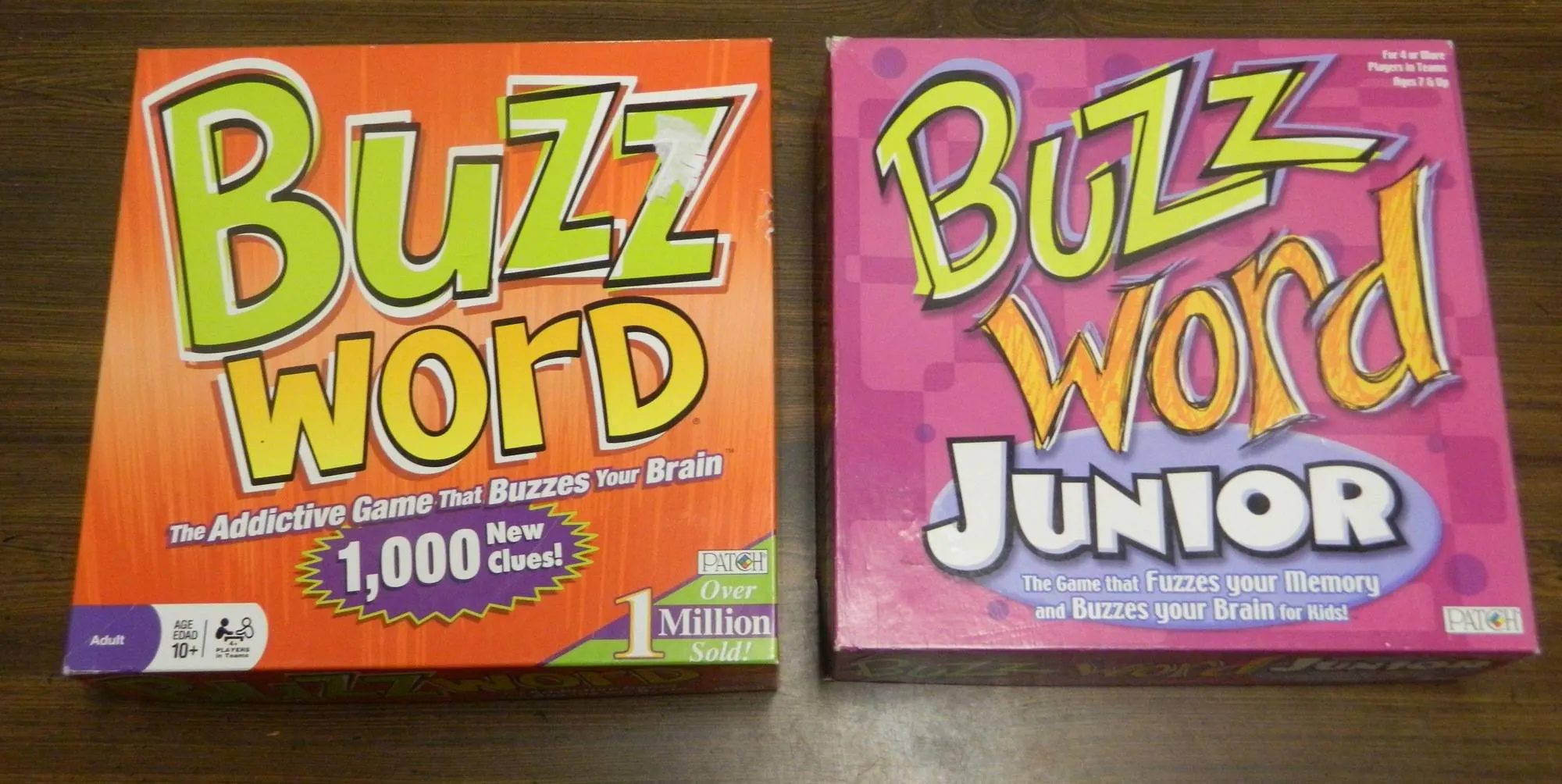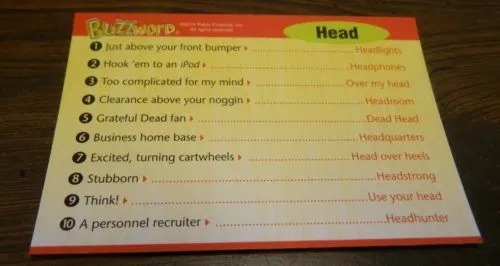When you first see Buzzword it is not really a game that sticks out in any noticeable way. Buzzword looks like every other generic party game that you see hundreds of times. Adding in a main mechanic of trying to get your teammate to guess a phrase and Buzzword is not a game that screams a lot of originality. Before playing Buzzword I didn’t think it was going to be a terrible game but I felt it was going to be one of the most generically average party games that I had ever played. Buzzword might not be a fantastic game but I will admit that I was actually pleasantly surprised by it.
How to Play Buzzword
These rules apply to both Buzzword and Buzzword Junior. Both games share most of the same mechanics I have noted the differences in Buzzword Junior below.
Setup
- The players divide into two teams and each team chooses a name and writes it on their side of the scoreboard.
- The card box is placed in the middle of the table.
- Shuffle the 10 scoring cards and deal them out evenly to both teams. The teams add up the numbers on the cards they were dealt. Whichever team has more valuable cards will get to start the game.
- All of the scoring cards are then organized by number with number one on top and ten on the bottom.
Playing the Game
On a team’s turn one of the players will be the reader and the other players on the team will be the guessers. This role rotates each round. The reader will read the buzzword to their teammates. This word will be part of every answer for the round. The timer is flipped over and the round begins.
The reader will read out the first clue written on the card. The guessers will have to try and guess the answer remembering that every answer will feature the buzzword. The guessers can make as many guesses as they want. When the team guesses right they move onto the second clue and so on. To indicate which answers were correct, the opposing team will place the corresponding number cards face down on the table. If an answer is not exactly the same but close you can use your judgment to determine whether the answer should count.
If at any time the guessers can’t think of the answer they can pass and move onto the next clue. The opposing team will place the corresponding scoring card number side up. The guessers will not be able to return to the clue though even if they have time remaining.
When the timer runs out the current team’s round ends. The opposing team will then have an opportunity to guess the answers to the clues that the other team either passed or didn’t have time to answer. The opposing team only gets one guess for each clue and they must answer shortly after the clue is read.
After the opposing team has had an opportunity to guess, both teams will score points equal to how many answers they were able to get correct.

The team on the left correctly guessed six of the answers so they will score six points. The team on the right got three answers correct so they will score three points.
End of Game
When one or both of the teams have reached 50 points the game ends as long as both teams have had the same number of turns. Whichever team has scored more points wins the game.

The team on the right scored 53 points while the left team scored 52 points. The right team would win the game.
Differences in Buzzword Junior
Buzzword Junior follows the rules of regular Buzzword except for the following exceptions:
- Each card in Buzzword Junior features five clues/answers instead of ten like in the normal Buzzword.
- To choose which team goes first both teams draw one number card. Whichever team draws the higher card gets to go first.
- A player from the opposing team reads the clues to the other team.
- To make the game easier for younger children you can choose to flip over the timer twice to give them more time.
- The game ends when one team has scored 30 points. If the other team hasn’t had as many turns, they get one more turn. Whichever team has the most points wins the game.
My Thoughts on Buzzword
For those of you unfamiliar with Buzzword I would say that it compares closely to the Pyramid television show and line of board games. Basically the goal of both games is for one player to give clues to the other player(s) on their team in order to get them to guess a set of words/phrases in a given amount of time. Buzzword has only two areas where the gameplay diverges from Pyramid. First all of the words/phrases in Buzzword utilize the current round’s buzzword. The other major difference is the fact that in Buzzword players read the clues already written on the cards while in Pyramid the players have to come up with their own clues.
While it doesn’t drastically change the gameplay, I kind of liked the twist that all of the words/phrases used the current buzzword. The reason that I like this mechanic is that it gives players a starting point for every phrase. Since the answer has to use the buzzword you can quickly narrow down potential answers instead of going through all of the potential answers that could fit a clue. I also think it is kind of fun trying to think of all of the different ways that a single word can be used. People who like word games will probably appreciate this aspect of the game.
Being a party game it shouldn’t surprise anyone that Buzzword is really easy to pick up and play. With how straightforward the game is I can’t see it taking more than a couple minutes to explain the game to new players. I think the game should work pretty well with both kids and adults. I would probably only recommend playing the normal version of the game with older kids though mostly because younger kids probably won’t be familiar with quite a few of the phrases used in the game.
Anyone who has played a lot of party games can probably already tell that Buzzword is not a highly original game. While the game has its’ own twists, the basics of the game play like every other party word game. There are a lot of party word games out there and Buzzword fails to really differentiate itself from a lot of the other games in the genre. If you have played other party word games you probably have already played a game very similar to Buzzword.
Other than not being highly original, the biggest problem with Buzzword is the fact that all of the clues/answers were not created equal. While I can see it being pretty hard to make all of the cards in a trivia game the same difficulty, I still hate it when it happens. The reason I hate it is the fact that the difference in difficulty between cards can have a pretty big difference on the game. For example if one team draws a really easy card they likely will get most of the answers which will score them a lot of points. The next team then might draw a hard card and only get a couple points. Just due to the difficulty of the cards the first team in this scenario would score quite a few more points than the second team. I have never liked this because it always leaves a feeling questioning whether a team won because they were truly better or because they had more luck in drawing easy cards. I believe luck should never play much of a role in these type of games.
I think this problem is compounded by the fact that there seems to be no rhyme or reason to how the clues are arranged on the cards. Going into the game I assumed the easiest answers came first with the hardest answers being the last couple of clues on the card. This does not seem to be the case though with Buzzword. The hardest clues for any given card could be anywhere on a card. Basically this forces the players to decide whether it pays to waste time trying to solve one of the harder clues or if they should just pass and move onto easier clues. While this gives the game a slightly interesting trade off mechanic I think it would have been better to try and sort the clues by difficulty with the hardest clues being at the end of the cards.
The fact that the cards difficulty varies is made worse due to the fact that for the most part the game is kind of on the easy side. For a lot of the cards it is not that hard to get most of the answers within the time that the game gives you. While some of the clues aren’t that helpful, most of the clues are quite obvious which allows you to get the answers almost instantaneously. Not surprisingly Buzzword Junior is even easier. If you are looking for a real challenge from Buzzword you probably aren’t going to get it.
The fact that the game is so easy makes it pretty short. Usually it is a positive for these type of party games to be short. I think it goes a little too far in Buzzword though. The game feels like it ends almost as soon as it begins. I think you can usually complete a game of Buzzword in around 20 minutes. Buzzword could have benefited from being a couple rounds longer as I think the game would have been best at around 30-45 minutes.
The final problem that I had with Buzzword is that the game is pretty boring when you are the reader. When you are the reader you do nothing other than read the next clue on the card. Most party games have the reader actually contribute something to the game but that is not the case in Buzzword. While I like that the game includes a clue for every answer I am wondering if the game could use a variant rule where after reading the given clue the reader could add their own clue to help players guess the word. Letting the reader add their own clues would keep the reader more engaged and would add a mechanic that would reward teams that gave good clues. The only concern I have about this house rule would be that it might make the game even easier than it already is.
With this review being for both Buzzword and Buzzword Junior I have mostly talked exclusively about Buzzword so far. That is mostly because the two games for the most part are exactly the same. Without having any children to play the game with you might wonder why I even picked up Buzzword Junior. The main reason I picked it up is that I usually like to pick up both the regular and junior versions of games if I can find them for cheap since for a lot of the games you can add the junior cards to the base game in order to give you more cards for the game. For example with Apples to Apples the junior version of the game can serve as additional cards for the normal version of the game.
I was hoping this would apply to Buzzword as well but it doesn’t. The problem with Buzzword Junior is the fact that each card only has five clues and they are significantly easier than the cards from the normal game. Due to these two facts you really can’t add them to the normal version of the game. With a different number of clues the cards give players less opportunities to score points but it is much easier to get all of the answers correct. Since the cards can’t be added to the base game I honestly can’t see any reason to purchase Buzzword Junior unless you have children to play the game with. I just can’t see adults enjoying the cards because they are way too easy.
As far as the components are concerned I would say that Buzzword does a very solid job. Basically all of the components included with the game are of a quality you would expect from a typical party game. The artwork is solid but nothing special. The best thing about Buzzword’s components is the fact that the game actually comes with quite a few cards. The game includes 200 cards which are double sided which means you can play 400 rounds before you will have to repeat a card. While I would always like for these type of games to include more cards I don’t think you can really be disappointed with how many are included with the game.
So I will admit that I have spent the majority of this review talking about the negatives of Buzzword. With Buzzword it is much easier to talk about Buzzwords negatives than its’ strengths because Buzzword is such a generic game. That doesn’t mean that Buzzword is a bad game though. I had fun with Buzzword and I plan on playing it again in the future. It is just that Buzzword is a very solid yet unspectacular party word game. You can fun with the game but it doesn’t really do a lot that makes it stand out among other party word games. Basically Buzzword is the definition of a very average board game.
Should You Buy Buzzword?
When you look at Buzzword you see a very generic party word game. The idea of having to guess different words/phrases that all use the same word is an interesting idea. I had fun with Buzzword and I would play the game again. Buzzword is a very generic game though as it is not much different than other party word games outside of its’ buzzword twist. The game also has some problems with some cards being easier than others and the game for the most part being a little on the easy side. The reader also doesn’t have a lot to do in the game. While Buzzword has some problems it is still a very solid party word game.
If you don’t really like party word games or already have too many I would probably recommend passing on Buzzword since it doesn’t do anything original enough to make itself really stand out. If you like party word games like Pyramid though I think you can have quite a bit of fun with Buzzword. Between Buzzword and Buzzword Junior I would recommend the normal Buzzword for most people. I would only recommend Buzzword Junior over the original game if you have young children as the game is too easy for adults. Overall I would probably recommend waiting for a good deal before purchasing either version of the game.
If you would like to purchase Buzzword or Buzzword Junior you can find them online: Buzzword Amazon, Buzzword Junior Amazon
, Buzzword eBay
, Buzzword Junior eBay


